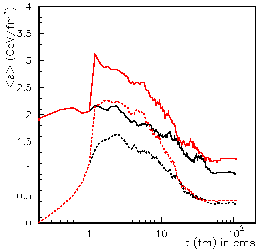- Lawrence Berkeley National Laboratory
B. Gibbard
- Brookhaven National Laboratory
D. Malon
- Argonne National Laboratory
(See http://www-rnc.lbl.gov/GC/ for full collaboration list.)

Grand Challenge Application on HENP Data
Focussed on
Efficient Data Access for RHIC
The purpose of this project is to develop techniques and tools that will enable efficient access to the massive datasets of modern High-Energy and Nuclear Physics (HENP) experiments, particularly for experiments at the Relativistic Heavy ion Collider (RHIC) beginning in late 1999, in their search for the Quark-Gluon-Plasma (QGP). Access to these 100TB+ datasets by hundreds of scientists, in conjunction with carrying out the large-scale computations necessary to refine and reduce them to the essential physical properties buried within, is one of the forefront problems of high-performance computing today.
The principle approach to this problem is cast it in the form of an extremely large hierarchical collection of objects (some persistent and some transient) that experience has shown is very well matched to this event-based experimental data. Modern object-database technology allows us to address the issue of physical storage layout separately from the logical relationships between the objects. The primary issue for physical storage is to organize the data so that it is stored according to how it is accessed rather than by how it is generated. The NERSC T3E is used to simulate the relativistic heavy ion collisions that will occur at RHIC and produce a dataset with these characteristics for which expected access patterns can be studied. The newly installed HPSS system at NERSC enables us to address issues related to effectively coupling the required amount of high-performance computing cycles to these massive object databases.
The NERSC T3E is used to calculate theoretical predictions of what may occur in the relativistic nuclear matter collisions at RHIC. These collisions will produce matter under conditions that have never before been produced in a laboratory. A method being employed to address the uncertainties is to calculate this matter under various initial conditions and then propagate it in time (and space) in order to see the effects in the detector data. The figure above shows an example of such a calculation performed on the T3E, showing the energy density within the nuclear matter for a time range spanning the duration of the collision.
See http://www-rnc.lbl.gov/GC/ for additional accomplishments and results of R&D tests.
The direct significance of this work is to enhance the capabilities of large-scale experimental high-energy and nuclear physics to achieve their full scientific potential in exploring new regions of the physical world.
"High-Speed Distributed Data Handling for On-Line Instrumentation Systems", W. E. Johnston, et al. Proceedings of ACM/IEEE SC97: High Performance Networking and Computing.
Relativistic Heavy Ion Collider (RHIC) – http://www.rhic.bnl.gov/
HENP Grand Challenge Project - http://www-rnc.lbl.gov/GC/